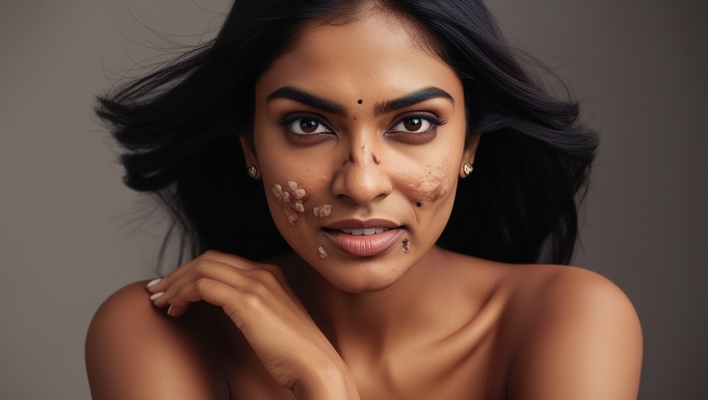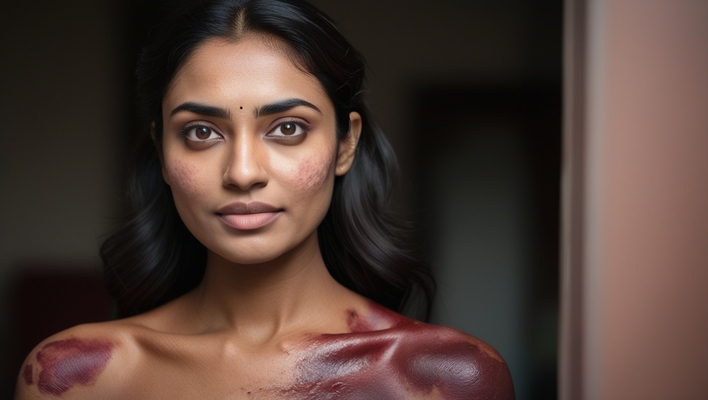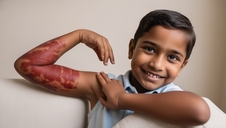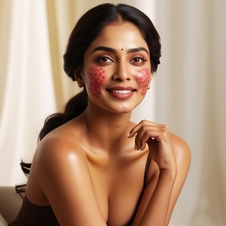Types and Treatments of Common Skin Diseases
Explore various types and treatments of common skin diseases. Understand symptoms, causes, and remedies for better skin health. Explore various types and treatments of common skin diseases to understand symptoms and remedies. Stay informed about skin health.
The skin is the largest organ in the human body and it performs many vital functions. It protects us from the elements, helps regulate our body temperature, and eliminates toxins through sweating. The skin is also an important part of the immune system, as it helps to keep harmful bacteria and viruses out of the body.
However, the skin is also susceptible to a number of diseases and conditions that can cause pain, itching, and other problems. Some of the most common skin diseases include eczema, psoriasis, dermatitis, and skin cancer. Fortunately, there are a number of effective treatments available for these and other skin conditions.

Table of Contents
1. Types of Common Skin Diseases 2. Treatments for Common Skin Diseases 3. Eczema 4. Psoriasis 5. Acne 6. Rosacea 7. Hives
1. Types of Common Skin Diseases
Common Skin Diseases:
There are many different types of skin diseases, each with its own set of symptoms and treatment options. Here are some of the most common types of skin diseases: Atopic dermatitis, also known as eczema, is a chronic (long-lasting) disorder that causes the skin to become dry, itchy, and inflamed.
Treatment options include avoiding triggers (such as irritants or allergens), using moisturizers and anti-itch creams, and taking oral antihistamines. Psoriasis is a chronic (long-lasting) condition that causes the skin to become dry, itchy, and red.
Treatment options include using moisturizers, taking oral antihistamines, and using topical corticosteroids. Acne vulgaris, or simply acne, is a common skin condition that causes pimples or zits to form. Treatment options include using over-the-counter acne creams or gels, using prescription medications, and undergoing laser therapy.
Rosacea is a chronic (long-lasting) condition that causes the face to become red and inflamed. Treatment options include avoiding triggers (such as alcohol or spicy food), using topical creams or gels, and taking oral antibiotics. There are many other types of skin diseases, each with its own set of symptoms and treatment options.
If you think you have a skin disease, it is important to see a dermatologist (skin doctor) to get a diagnosis and find the best treatment plan for you.
2. Treatments for Common Skin Diseases
There are many different treatments for common skin diseases, depending on the specific disease. Some common treatments include: -Topical treatments such as creams, ointments, or gels that are applied directly to the skin.
Oral treatments such as pills, capsules, or tablets that are taken by mouth. -Light therapy, also called phototherapy, which uses ultraviolet (UV) light to treat the skin. -Surgical treatments such as skin grafts, laser surgery, or cryosurgery, which involves freezing the skin.

3. Eczema
Eczema is a common skin condition that can be both embarrassing and painful. It is characterized by red, itchy, and inflamed skin. There are several different types of eczema, each with its own set of symptoms. The most common type of eczema is atopic dermatitis, which typically appears in childhood.
Other types of eczema include contact dermatitis, seborrheic dermatitis, and nummular eczema. There is no cure for eczema, but there are treatments that can help to manage the symptoms. Moisturizers are often used to help soothe the skin and reduce inflammation.
Topical corticosteroids may also be prescribed to reduce inflammation and itching. In severe cases, oral corticosteroids or immunosuppressants may be necessary. Eczema can be a frustrating condition to deal with, but with the help of a dermatologist, it is possible to find a treatment plan that works for you.
4. Psoriasis
People with psoriasis have patches of thick, red skin with silvery scales. The patches are often itchy and can be found anywhere on the body, but most often occur on the elbows, knees, scalp, lower back, face, palms, and the soles of the feet. Psoriasis is a chronic, lifelong condition.
There is no cure, but there are many treatments that can help to control the symptoms. There are four main types of psoriasis: plaque, guttate, inverse, and pustular. Plaque psoriasis is the most common type, and it is characterized by raised, red patches of skin covered with silvery scales.
Guttate psoriasis is characterized by small, red spots on the skin. Inverse psoriasis occurs in the folds of the skin, such as the armpits and groin. Pustular psoriasis is characterized by small, red bumps filled with pus. Psoriasis can be a mild, moderate, or severe condition.
Mild psoriasis can be treated with creams or ointments that are applied to the skin. Moderate to severe psoriasis may require oral or injectable drugs. ultraviolet light therapy, and biologic drugs. Psoriasis is a chronic, lifelong condition.
There is no cure, but there are many treatments that can help to control the symptoms. If you have psoriasis, it is important to work with a dermatologist to find a treatment plan that works for you.

5. Acne
Acne is a very common skin condition that affects people of all ages. It is characterized by the presence of pimples, blackheads, whiteheads, and other blemishes on the skin. Acne can be a very embarrassing and frustrating condition, but there are fortunately many treatments available.
One of the most common treatments for acne is the use of topical Retinoids. These are Vitamin A derivatives that help to unclog pores, and they are available both over-the-counter and by prescription. Another common topical treatment is Benzoyl peroxide, which is an antibacterial agent that can help to kill the bacteria that often contribute to acne.
Oral medications are also available for acne, and these include antibiotics, hormonal agents, and isotretinoin. Antibiotics help to kill the bacteria that can cause acne, while hormonal agents can help to regulate the hormones that can trigger acne breakouts.
Isotretinoin is a powerful medication that is typically only used as a last resort, as it can have some serious side effects. There are also many lifestyle changes that can help to improve acne. These include avoiding touching or picking at the skin, maintaining a clean face, and avoiding oily and sugary foods.
Getting plenty of rest and exercise can also help to reduce stress, which can trigger acne breakouts.
6. Rosacea
Rosacea is a common condition that is characterized by redness and pimples on the face. It can also cause burning and stinging sensations. Rosacea can affect people of all ages, but it is most common in adults aged 30-60. There are four subtypes of rosacea, each with its own set of symptoms.
The first subtype is characterized by redness and flushing of the face. The second subtype is characterized by pimples and bumps on the face. The third subtype is characterized by thickening of the skin on the face. The fourth subtype is characterized by eye irritation.
There is no cure for rosacea, but there are treatments that can help to control the symptoms. The most common treatments are topical creams and oral antibiotics. Topical creams can help to reduce the redness and inflammation of the face. Oral antibiotics can help to reduce the number of pimples and bumps on the face.
If you think you might have rosacea, it is important to see a doctor for a diagnosis. There are also a number of self-care measures that you can take to help to control the symptoms of rosacea. These include avoiding triggers that can worsen the condition, using gentle skincare products, and avoiding sunlight.

7. Hives Hives, also known as urticaria, are raised, itchy welts that appear on the skin. They are usually the result of an allergic reaction and can be triggered by a number of things, including food allergies, medications, and insect bites. Hives can be short-lived, lasting just a few minutes, or they can persist for days or weeks.
In some cases, hives may be a sign of a more serious condition, such as an autoimmune disease. There are several different types of hives, each with its own cause and treatment. The most common type of hives, called acute hives, last less than six weeks.
They are often the result of an allergic reaction to a food or medication. The welts associated with acute hives are usually small and disappear within a few hours. Chronic hives, on the other hand, last more than six weeks and can be the result of an underlying medical condition.
The best way to treat hives is to identify and avoid the trigger. If you are allergic to a particular food, for example, you will need to avoid that food. If you are taking a medication that is causing the hives, your doctor may be able to switch you to a different medication.
In some cases, hives may require treatment with medication. Antihistamines, for instance, can help to relieve the itchiness and swelling associated with hives. There are many types of skin diseases, but some are more common than others.
The most common skin diseases are acne, eczema, psoriasis, and rosacea. Each of these can be treated with a variety of methods, but the most effective method depends on the individual disease. Acne can be effectively treated with over-the-counter medications, but more severe cases may require prescription medications.
Eczema is often treated with topical corticosteroids, but other treatments may be necessary depending on the severity of the disease. Psoriasis can be treated with topical treatments, light therapy, or systemic medications. Rosacea is often treated with topical treatments, but more severe cases may require oral medications.
Conclusion: Skin illnesses incorporate many circumstances, each with particular side effects and causes. Normal skin sicknesses like skin break out, dermatitis, psoriasis, rosacea, and contagious diseases can be overseen really with the right therapies. Early analysis is fundamental, as brief treatment can mitigate side effects and forestall entanglements.
Treatment choices incorporate skin creams, oral prescriptions, way of life changes, and, in additional extreme cases, treatments like phototherapy or laser medicines. Counseling a dermatologist is vital to getting a legitimate finding and making a customized treatment plan custom-made to individual requirements. The use of soap, soda, Dettol is prohibited for skin irritation.
Skin Diseases and Homeopathy
Skin diseases vary widely in terms of symptoms and causes, but they can often be effectively managed through both conventional medicine and homeopathy. While modern medicine offers treatments such as topical creams, oral medications, and therapies like phototherapy or laser treatments, homeopathy provides an alternative approach by focusing on natural remedies tailored to the individual’s unique symptoms and overall constitution.
Both approaches aim to relieve discomfort and promote healing, and some individuals find benefit in combining homeopathic treatments with conventional care. It is crucial to consult with a healthcare professional, whether opting for homeopathy or conventional treatment, to ensure a comprehensive and safe management plan for the skin condition.
Skin diseases, ranging from acne and eczema to psoriasis and fungal infections, affect millions of people worldwide. While conventional treatments include topical creams, oral medications, and therapies like phototherapy, homeopathy offers a natural alternative.
Homeopathy approaches skin diseases holistically, focusing on the individual’s overall health rather than just the symptoms. Remedies are chosen based on the patient’s unique constitution, taking into account their physical, emotional, and mental state. Common remedies like Sulphur, Graphites, and Arsenicum album are often used for treating various skin conditions, such as eczema, itching, and rashes.
Homeopathy emphasizes strengthening the body’s immune system to promote self-healing. While some people experience relief using homeopathy, its efficacy varies from person to person. It’s essential to consult a professional homeopath to receive a tailored treatment plan and combine it with proper skin care and lifestyle practices for optimal results.
You can use a soap or shampoo that the doctor prescribes. They should only be used by patients with skin diseases. Do not wear dirt, dust, sweat, dust, dirty clothes. Always be careful. Contact your doctor if necessary. We are here for all your suggestions.
I am Doctor KM Rezaul Karim Mukul, DHP Health, Gulgular Mor, Turag, Uttara, Dhaka, Bangladesh. WhatApps no: +8801914259617, email: k.mukul31@gmail.com, web: www.dhp7.com
thanks: app.leonardo.ai and Google.
